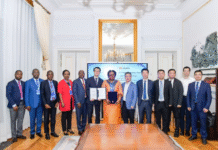Illustrative Image: Transforming Education in West Africa: How ICAP and Growth Mindset Can Redefine Classroom Engagement
Image Source & Credit: Technext
Ownership and Usage Policy
In September 2025, HolonIQ’s Education in 2030 report highlighted an urgent reality: global education systems must evolve to meet the demands of a rapidly changing world. For West Africa, where educational inequality, infrastructure gaps, and cultural complexities intersect, this evolution cannot simply mirror Western models. It must be uniquely African.
The work of two leading scholars—Michelene Chi, with her ICAP engagement framework, and Carol Dweck, with her research on growth mindset—provides critical foundations for rethinking learning. But their ideas, while powerful, cannot be transplanted wholesale. They must be adapted, expanded, and reimagined to suit West African realities, where classrooms are often overcrowded, technology is scarce, and cultural values shape learning in distinct ways.
As an edtech product designer working across Nigeria and West Africa through DO Take Action, I have seen both the promise and the limitations of applying these frameworks without adaptation. The task before us is not only to move students from passive to active learning, but to redefine what “engagement” and “mindset” mean in communities where education itself is contested, fragile, and yet profoundly valued.
The Reality Check: Classroom Conditions in West Africa
Statistics paint part of the challenge:
-
Only 25% of higher education students in Sub-Saharan Africa pursue STEM, and less than 30% of those are women.
-
In Nigeria, 10.5 million children aged 5–14 are out of school, and only 61% of 6–11 year-olds attend primary school regularly.
-
As of 2018, fewer than 10% of Nigerian universities had video conferencing facilities, and the system faced a 30% teacher deficit.
But numbers only tell half the story. In practice, I encounter classrooms with more than 60 students to one teacher, intermittent electricity, and minimal access to teaching aids. Here, “interactive learning” cannot look like it does in Silicon Valley or London. It must look like children huddled around a single phone for research, or like students inventing learning games with chalk and borrowed notebooks.
This is where Chi’s ICAP framework—which categorizes learning into Passive, Active, Constructive, and Interactive modes—requires contextual expansion.
ICAP in Context: From Individual to Collective Engagement
Chi’s original ICAP framework assumes engagement is largely individual. But in West Africa, learning is inherently communal. Peer groups, family networks, and cultural traditions shape how students engage. Through my work, I’ve observed a Community-ICAP Model better suited for our context:
-
Collective Passive: Large-group listening, often with shared cultural cues and peer reinforcement that make even “passive” learning more dynamic than in Western settings.
-
Resourceful Active: Students creatively engage limited materials—sharing a single textbook among five, pooling funds for data bundles, or improvising lab experiments with household tools.
-
Culturally Constructive: Students build knowledge by connecting formal content with indigenous knowledge systems—such as linking coding logic to local storytelling traditions or agricultural practices.
-
Networked Interactive: Collaboration expands beyond classrooms, involving family, community leaders, and peers across social networks. Knowledge is not just exchanged; it is validated communally.
This shift highlights that engagement in African classrooms is not just about individual cognition, but about social resilience and cultural adaptation.
Growth Mindset Meets Cultural Reality
Carol Dweck’s growth mindset research argues that students thrive when they believe abilities can be developed through effort. For West Africa, this principle is both inspiring and insufficient on its own.
Why? Because believing in one’s potential is hard when systemic barriers—poverty, gender discrimination, poor infrastructure—persist. For instance:
-
In north-eastern and north-western Nigeria, female primary net attendance rates hover below 48%.
-
Families face hidden costs—levies, uniforms, supplies—that undermine the promise of “free” basic education.
Here, nurturing a growth mindset is not just about telling girls they can succeed in STEM; it’s about removing structural barriers and showing that their communities believe in their potential.
From my Master’s studies in Social and Public Policy, I’ve learned that mindset shifts must align with systems change. For growth mindset to take root, three strategies are essential:
-
Economic scaffolding: Subsidizing data, designing offline tools, and reducing cost barriers.
-
Cultural bridging: Linking STEM learning to traditional crafts, farming methods, or local entrepreneurship.
-
Peer network activation: Building learning communities that extend beyond school hours into family and neighborhood life.
When growth mindset is embedded in both psychology and policy, it becomes a transformative force.
Technology as an Enabler—But Designed for Constraint
Chi and Dweck both note the role of technology in enhancing engagement. Yet in West Africa, technology cannot assume consistent electricity, connectivity, or device access.
Practical design principles for “Technology-Enhanced ICAP” in Africa include:
-
Offline-first design: Apps that work fully offline and sync only when connectivity is available.
-
Shared device models: Protocols for equitable use of one device among many learners.
-
Voice-based learning: Tools that leverage oral traditions and low literacy levels.
-
Data-light interfaces: Solutions optimized for minimal bandwidth.
At DO Take Action, some of our most effective STEM apps integrate local storytelling traditions, bilingual interfaces (English + indigenous languages), and group problem-solving features. Technology works best when it amplifies cultural practices instead of replacing them.
From Classrooms to Systems: Scaling ICAP and Growth Mindset
True transformation requires moving beyond isolated classroom interventions toward systemic change:
-
Teacher Capacity Building: Training teachers not just in engagement methods, but in how to adapt these methods for overcrowded, under-resourced classrooms.
-
Community Partnerships: Positioning parents, elders, and community leaders as co-educators who reinforce growth mindset cultures at home.
-
Policy Reform: Advocating for assessment systems that reward effort, creativity, and collaboration rather than reinforcing fixed-ability sorting.
-
Infrastructure Investment: Building sustainable edtech ecosystems designed for Africa’s realities, not retrofitted from Western contexts.
The African Union’s 2024 Year of Education initiative—focused on creating “an African fit for the 21st century”—offers a powerful policy window. But seizing this opportunity requires aligning ICAP and growth mindset with African-centered educational design.
Conclusion: Redefining Engagement for African Futures
The promise of Chi’s ICAP framework and Dweck’s growth mindset is real. But for West Africa, their power lies not in replication, but in reinvention. Engagement here means community as much as individual effort. Growth mindset here means resilience against systemic barriers as much as personal belief.
Our future depends on designing learning environments that are culturally resonant, technologically adaptive, and structurally supportive. This is not a story of Africa catching up to the West—it is a story of Africa charting its own educational future, one that leverages cultural strengths, overcomes infrastructural weaknesses, and empowers the next generation of innovators and leaders.
If we succeed, West African classrooms will not just move “beyond passive learning”—they will redefine what global educational engagement looks like in the 21st century.
















 The African Research (AR) Index is a comprehensive scholarly directory and database focused explicitly on journal publishers that publish and disseminate African research.
The African Research (AR) Index is a comprehensive scholarly directory and database focused explicitly on journal publishers that publish and disseminate African research.

